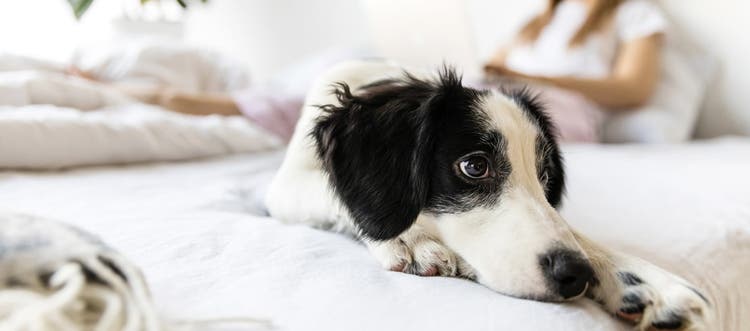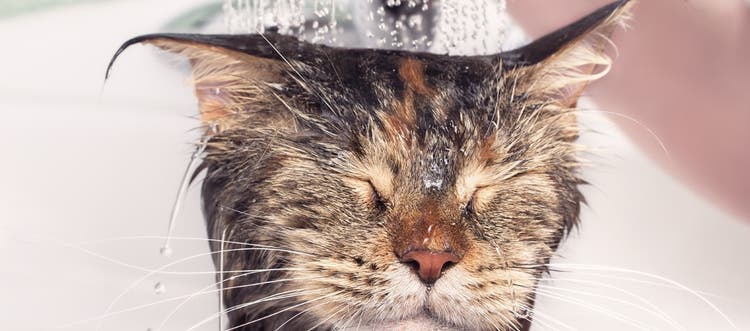Common culprits behind a cat with itchy skin.
When we imagine a scratching cat, we may think of ruined furniture or scratching posts — but what if your cat is clawing at their skin? Itchiness in pets is a fairly common ailment, but it’s important to properly diagnose the cause of discomfort. So why might your cat be itchy? And what can you do to treat it?
Why Is My Cat Itchy?
There are many potential causes for cats to itch, but they are often divided into three larger categories1:
- Infections: This includes parasitic infections that live on the skin, such as fleas, ticks, mites and other organisms. If your cat is strictly an indoor pet, don’t discount parasites; fleas are present in over 50% of itchy cat cases.1 Other common types of infections are bacterial and fungal cases or ringworm.
- Allergies: The most common allergies in cats are related to food, environment or flea bite hypersensitivity. This can include sensitivities to certain proteins, seasonal pollen and dust, cat litter, cleaning materials, plants or flea saliva.
- Other condition(s): If your cat’s itch isn’t attributed to any of the reasons above, your veterinarian may refer you to a veterinary dermatologist or specialists for further testing, such as skin biopsies or skin infection tests.
To further explore these categories, let’s go over the most common reasons your cat may be itching. Here are five potential reasons your cat may be scratching themselves more than usual:
1. Parasitic Infections
Many cats are strictly indoors, so owners may not see the necessity of administering flea and tick prevention. But don’t forget, 50% of itchy cat cases are due to fleas, which can even affect indoor cats.1 Indoor cats can still contract parasitic infections, which can travel on other pets or humans, too. Look for your cat itching on the back half of their body, especially near the base of the tail. Talk to your vet about a flea preventive regimen to reduce the odds that your cat’s itchiness is (or will be!) caused by fleas, even if they’re an indoor cat.
Flea and tick preventatives are effective in killing and repelling current parasites, so some vets will try those products first. They also help prevent infections from happening in the future. The Seresto® collar for cats kills and repels fleas and ticks for eight continuous months, protecting your cat from painful, itchy bites.
It’s also helpful to understand how to deal with pests at home, such as how to safely remove a tick from your cat or how to identify different pest infestations. If you don’t feel comfortable identifying the problem yourself, your vet can inspect your cat’s skin and fur using a flea comb or skin scrape to check for smaller mites.
2. Insect Bites
Just like humans, cats can be stung by wasps, bees, flies or mosquitoes. Cats can be especially sensitive to the insect saliva injected as they bite, which may cause large painful welts or excessive itching. Insects often target non-hairy, exposed areas to bite, such as the bridge of a cat’s nose or the tips of the ears. Check for small red lumps around areas without hair, especially during warmer months or if you have an outdoor cat.
3. Food Allergies
Yep, your furry friend can have pet food allergies and sensitivities, too. Grain allergies in cats are actually quite rare; instead, it’s more likely that your cat is allergic to proteins like chicken or fish.1 If you suspect your cat is allergic to their food, talk to your vet about testing.
A food test is one of the most effective ways to figure out what your cat is allergic to. Work with your vet to decide what to feed during this process. They may recommend a hydrolyzed diet, prescription pet foods that cannot elicit allergic responses because the proteins in the food are broken down enough that your cat’s immune system cannot recognize them. After several weeks, the vet may have you reintroduce the previous food. If your cat has a reaction, they’re most likely allergic to it.
4. Environmental Allergies
Did you know your cat can be allergic to pollen, grass, mold spores or house dust mites? You might even have to help manage seasonal allergies in your cat. Common symptoms may include a runny nose, coughing, watery eyes, sneezing or itchy and irritated skin.
If you want to find out what environmental factors your cat is allergic to, a diagnosis will involve intradermal allergy testing from your vet. As with humans, intradermal allergy testing involves injecting small doses of common potential allergens while the cat is under sedation or anesthesia and inspecting the skin’s reaction to each injection.
If you aren’t ready to test your cat yet, you can reduce allergens in your home by keeping your windows closed, washing your bedding frequently and avoiding spraying perfume or scented air fresheners around your cat. If you have an outdoor cat, avoid letting your cat outside when pollen or mold counts are high and wipe their paws when they come inside so they don’t bring allergens with them. Your vet may also prescribe an oral or injectable steroid to treat their skin irritation.
5. Bacterial or Fungal Infections
Bacterial and fungal skin infections invade your cat’s protective skin barrier and are more common in warm and humid conditions.2 Dermatophytosis — commonly known as ringworm — is the most common skin fungal infection in cats. Counter to what the name implies, there are no worms involved. Ringworm is caused by a fungus, and common symptoms include hair loss, redness, scaling, crusting and itching.
Many other infections have similar symptoms and can bring on fever, lethargy, coughing, weight loss or difficulty breathing.2 Contaminated environments and other animals are the most common culprits for these infections, and outdoor cats have a higher risk of exposure to infected elements.
Most healthy adult cats should have an immune system strong enough to fight off fungal or bacterial infections without human intervention. But stress, illnesses or a weak immune system may increase their risk.
To diagnose the issue, vets may try deep skin scrapes, skin cultures, biopsies or fecal cultures.2 Your vet may also have specific instructions on treatment based on your household environment, including treating other pets or cleaning bedding and carpets daily.
How to Treat an Itchy Cat
If your cat needs immediate at-home relief, here are a few solutions to try:
- Soothing baths: Warm water can help wash away scabs, dandruff and environmental allergens. There are shampoos made for cats that moisturize and reduce itch, and your vet may prescribe a medicated shampoo. It’s no secret that most cats don’t love baths, so thankfully other options are available.
- E-collar or cones: To keep you cat from licking an infected area, cones are a good temporary solution for reducing itching. While this won’t treat the problem, you might use it before your cat can see a veterinary or specialist.
- Veterinary treatments: A vet may prescribe antibiotics or antifungal products to treat infections. In some cases, they can give your cats steroids or recommend a hydrolyzed diet for protein allergies.
- Cleaning your home: Keep carpets, drapes, blankets, bedding and cat trees as clean as possible if you think your cat is experiencing environmental allergies.
It’s always hard to see your pet in discomfort, especially when it might be challenging to diagnose the problem. But rest assured, your vet is there to help figure it out, and there are many tips and resources to keep your cat healthy, happy and itch-free.
Resources
- “Why Your Cat Is Itchy and What You Can Do” (February 2, 2021). PetMD. https://www.petmd.com/cat/symptoms/skin/why-your-cat-itchy-and-what-you-can-do
- “Skin Fungal Infections in Cats” (June 17, 2022). PetMD. https://www.petmd.com/cat/conditions/skin/skin-fungal-infections-cats









